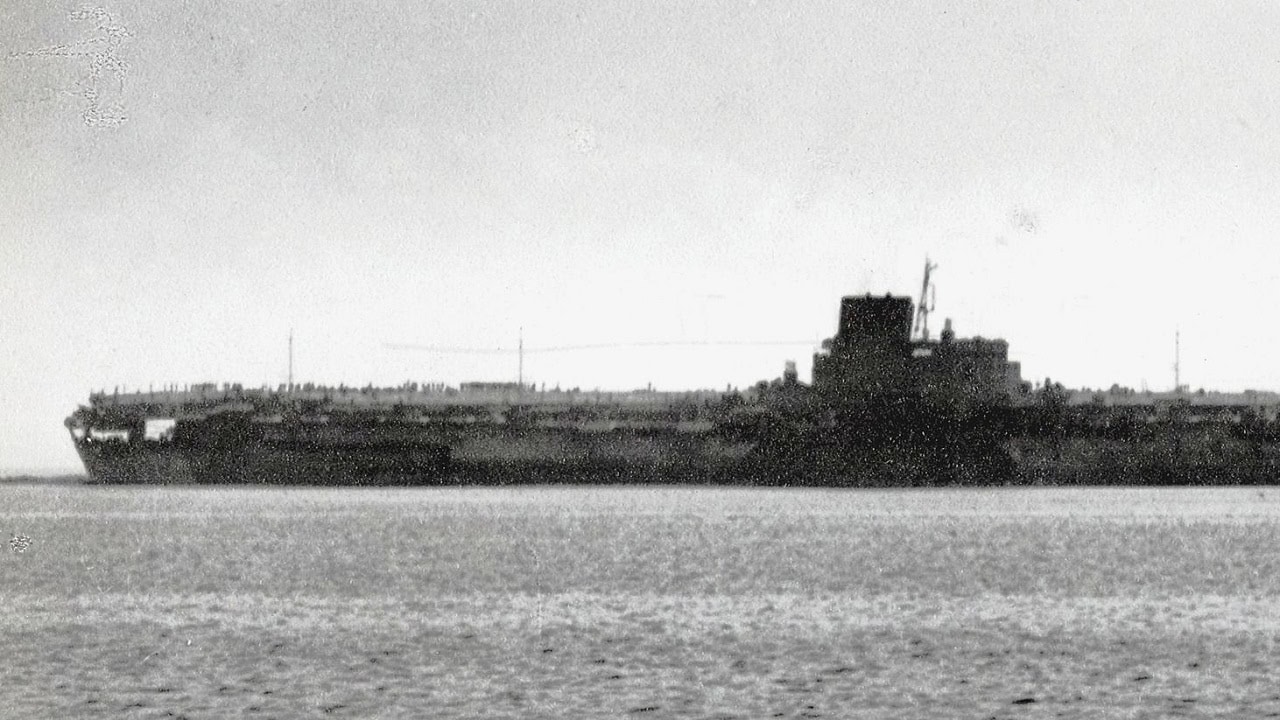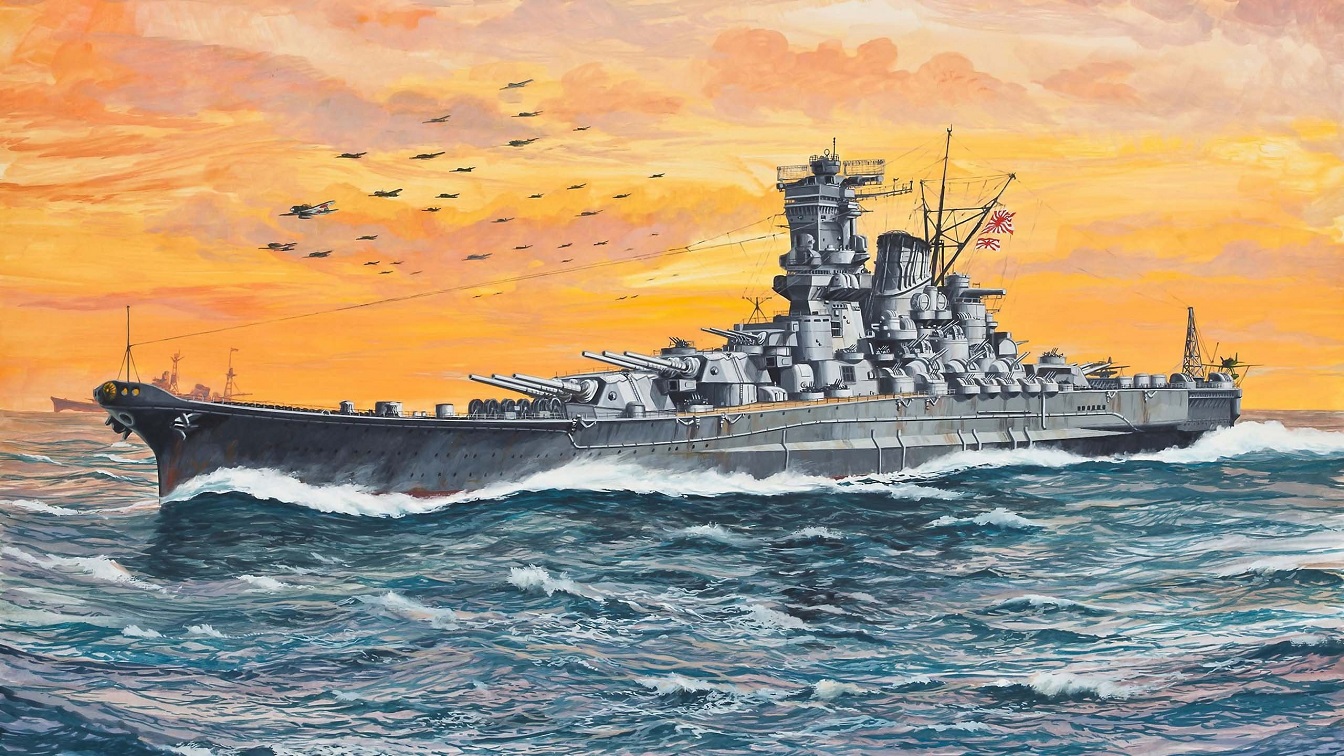Article Summary: The Yamato-class battleships were the pinnacle of naval engineering, boasting 18.1-inch guns and unparalleled armor. Designed to dominate the seas, they ultimately met their demise due to shifting naval warfare tactics favoring aircraft carriers.
Key Point #1 – Musashi succumbed to relentless air attacks at Leyte Gulf, while Yamato was sent on a one-way mission to Okinawa, overwhelmed by U.S. bombers. Shinano, converted into an aircraft carrier, was torpedoed just 10 days after commissioning.
Key Point #2 – Despite their sheer size and power, the Yamato-class battleships became symbols of an outdated era, proving that even the largest warships could not withstand the changing tides of war.
Yamato-Class Battleships: The Largest Warships Ever Built
The Yamato-class battleships were two battleships of the Imperial Japanese Navy–and they made some serious waves for many reasons.
They made history for a simple reason: they were the biggest battleships ever to be built, a title even the mighty U.S. Navy can’t claim.
Yamato and Musashi, whose hulls were laid down in November 1937 and April 1938, respectively, were completed as designed.
A third hull, laid down in 1940, was converted to the aircraft carrier Shinano during construction.
Displacing nearly 72,000 long tons (73,000 t) at full load, the completed battleships were the heaviest ever constructed.
The Yamato class carried the largest naval guns ever fitted to a warship, nine 460 mm (18.1 in) naval guns, each capable of firing 1,460 kg (3,220 lb) shells over 42 km (26 mi).
The Yamato was commissioned on December 16, 1941, just nine days after Pearl Harbor.
The Musashi was commissioned on August 5, 1942, and the Shinano was commissioned on November 19, 1944
Due to the threat of U.S. submarines and aircraft carriers, both Yamato and Musashi spent most of their careers in naval bases at Brunei, Truk, and Kure.
These were Japan’s most prestigious ships, and they didn’t want to risk losing them. Considering the expense to build such massive battleships, such a strategy made little sense and might have cost Imperial Japan dearly.
Yamato-Class: She Was Big, Powerful, and Fast
The Yamato class specs show just how massive these ships were.
General characteristics (as built)
Type: Battleship
Displacement: 71,659 long tons (72,809 t) (full load)
Length: 256 m (839 ft 11 in) (waterline)
263 m (862 ft 10 in) (o/a)
Beam : 38.9 m (127 ft 7 in)
Draught: 10.4 m (34 ft 1 in)
Installed power: 12 water-tube boilers
150,000 shaft horsepower (110 MW)]
Propulsion: 4 shafts; 4 steam turbines
Speed: 27 knots (50 km/h; 31 mph)
Range: 7,200 nautical miles (8,300 mi) at 16 knots (18 mph)
Complement: 2,767 officers and crew
Armament:
3 × triple 46 cm (18.1 in) guns
4 × triple 15.5 cm (6.1 in) guns
6 × twin 12.7 cm (5 in) guns
8 × triple 25 mm (0.98 in) AA guns
2 × twin 13.2 mm (0.52 in) machine guns
Armor:
650 mm (26 in) main turrets
410 mm (16 in) side armor (400 mm (16 in) planned on Shinano and No. 111), inclined 20 degrees
200 mm (8 in) armored deck (75%)
230 mm (9 in) armored deck (25%)
Aircraft carried:
4 Aichi E13A, 3 Mitsubishi F1M
2 catapults (Yamato, Musashi)
47 aircraft (Shinano)
Eighteen Inch Guns
The Yamato-class battleships had primary armaments consisting of three 3-gun turrets mounting 46 cm (18.1 in)/45 caliber Type 94 naval guns – the largest guns ever fitted to a warship, each of which weighed 2,774 tons for the complete mount. Each gun turret was more than the weight of most destroyers.
Each gun was 21.13 m (69.3 ft) long and weighed 147.3 metric tons, and could fire 1,460 kg (3,220 lb) armor-piercing shells and 1,360 kg (3,000 lb) high explosive shells out to 42.0 km (26.1 mi) at a rate of 1½ to 2 shells per minute.
The Musashi
Musashi was the second of the Yamato class. Until July 1944, she shifted between the naval bases of Truk, Yokosuka, Brunei, and Kure. On March 29, 1944, she sustained moderate damage near the bow from a torpedo fired by the American submarine Tunny. After repairs and refitting throughout April 1944, she rejoined the fleet.

The Japanese battleship Musashi leaving Brunei, Borneo, in 1944, possibly on 22 October, when she departed to take part in the Battle of Leyte Gulf. Photographed by Japanese sailor Tobei Shiraishi from the destroyer Isokaze.
In October 1944, she left Brunei as part of Admiral Takeo Kurita’s Center Force during the Battle of Leyte Gulf. Musashi was sunk on 24 October during the Battle of the Sibuyan Sea, after being savaged by US aircraft.
The Musashi took 17 bombs and 19 torpedo hits, with the loss of 1,023 of her 2,399-man crew.
Shinano (converted aircraft carrier)
The Shinano began as the third of the Yamato class. However, in June 1942, following the Japanese defeat at Midway, construction was suspended, and the hull was gradually rebuilt as an aircraft carrier.
She was designed as a 64,800-ton support vessel capable of ferrying, repairing, and replenishing the air fleets of other carriers. Although she was initially scheduled for commissioning in early 1945, the ship’s construction was accelerated after the Battle of the Philippine Sea.

Japanese aircraft carrier Shinano underway during her sea trials.
Shinano was launched on 5 October 1944 and commissioned on 19 November, a little more than a month later.
Her service life lasted just 10 days. On November 28, en route from Kure Harbor, the Shinano was picked up on sonar by the USS Archerfish, commanded by Commander J. F. Enright, as it ran on the surface.
At 0317 hrs, a spread of six “steam” torpedoes, set to run at ten feet, were fired at the green carrier. Four of them struck home a minute later. As destroyers maneuvered to contact Archerfish, the submarine evaded, confident she had dealt a mortal blow to a Shokaku-class aircraft carrier.
And Shinano began her death throes, which were to last until late the following morning. Around 1030hrs, the Shinano capsized and sank.
The Yamato, The Pride of the Imperial Japanese Navy
After serving as Admiral Yamamoto’s flagship during the Battle of Midway, Yamato spent the next two years intermittently between Truk and Kure naval bases, with her sister ship Musashi replacing Yamato as the flagship of the Combined Fleet.
During this time, Yamato, as part of the 1st Battleship Division, deployed on multiple occasions to counteract American carrier raids on Japanese island bases.
On 25 December 1943, she suffered major torpedo damage at the hands of USS Skate and was forced to return to Kure for repairs and structural upgrades.

Battleship Yamato. Image Credit: Creative Commons.
During the Battle of Okinawa, the Yamato was sent on a suicide mission as part of Operation Ten-Go, but before she could get to Okinawa to bring her big guns to bear on American forces, she was spotted and the Americans launched 386 planes to attack the Yamato and her supporting vessels. On April 7, 1945, the aircraft pounced in three successive attacks.
Ten bomb hits and at least eight torpedo hits rocked the Yamato. She capsized, and then one of her magazines exploded, sending a plume of smoke four miles high where it was seen 124 miles away and took 2,740 of the 3332 crew members with her, including Vice-Admiral Seiichi Itō.
Japan’s Yamato-class was the biggest and most powerful battleship ever built. However, it was built too late and suffered the fate of that lateness when the new king of the sea, the aircraft carrier, sank it.
About the Author: Steve Balestrieri
Steve Balestrieri is a 19FortyFive National Security Columnist. He served as a US Army Special Forces NCO and Warrant Officer. In addition to writing for 19FortyFive, he covers the NFL for PatsFans.com and is a member of the Pro Football Writers of America (PFWA). His work was regularly featured in many military publications.

